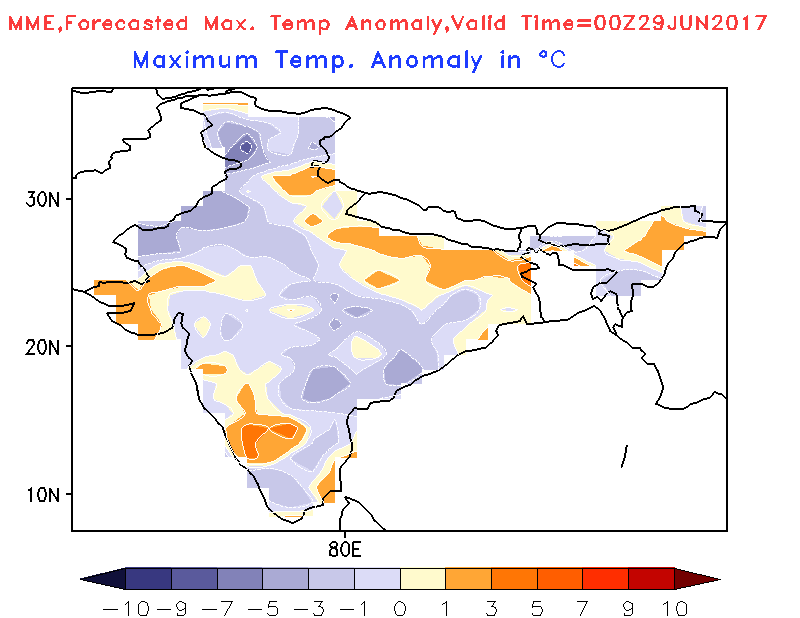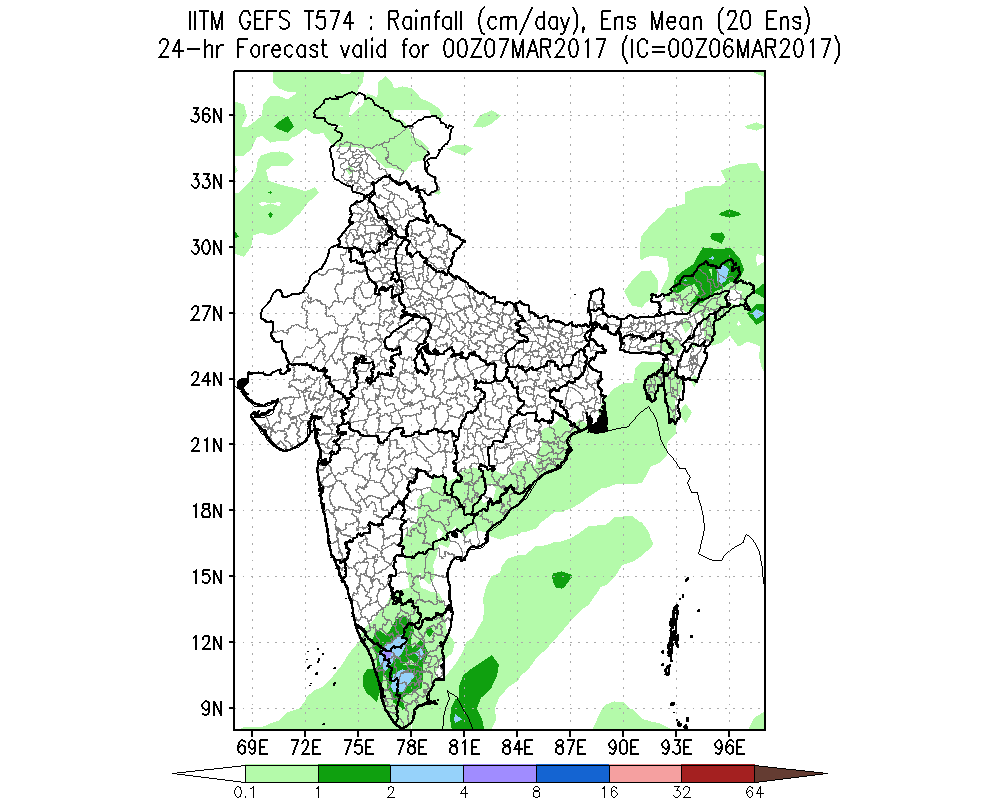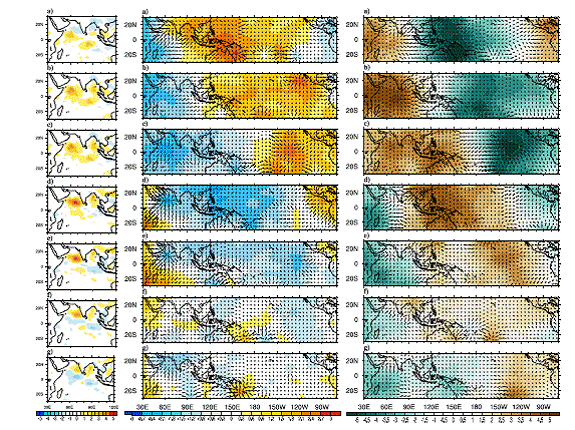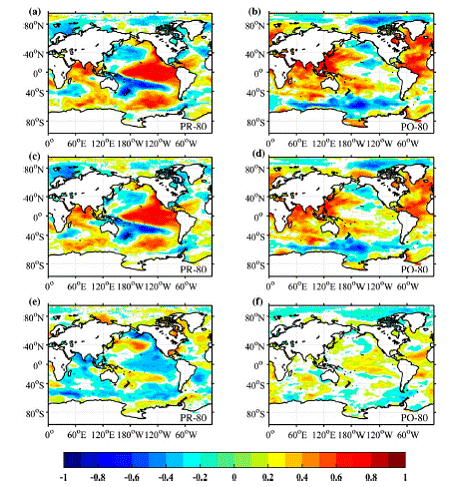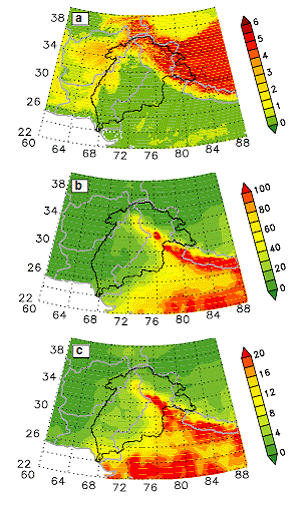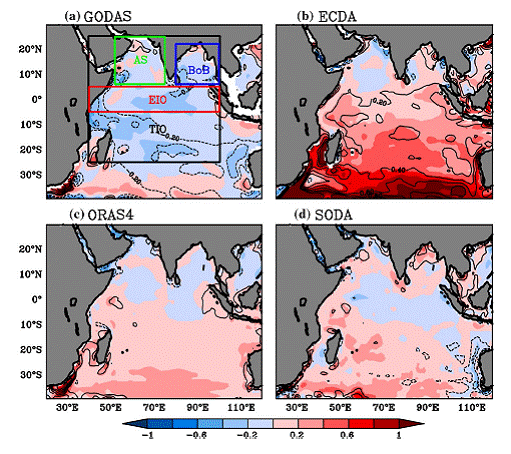SPECIAL LECTURE SERIES
RAC Meeting Presentations
IITM RESEARCH REPORT
Monthly, Seasonal and Annual Rainfall Time Series for All-India, Homogeneous Regions and Meteorological Subdivisions: 1871-2016 by Kothawale D.R., Rajeevan M., Aug 2017
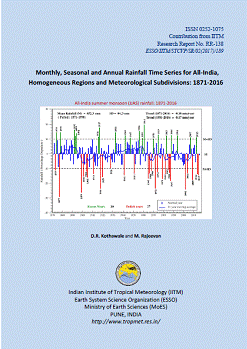 Read More
Read More
IITM Publication Highlights
How Does Indian Teak respond to Synoptic Rainfall Variation in multi-decadal Time Scale?
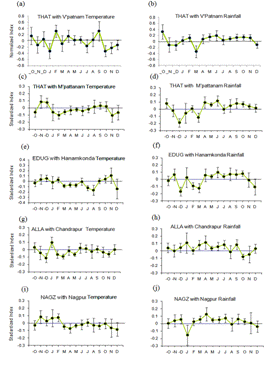 Monsoon (June-October) and Post monsoon (October-.November) rainfall amount in south east India exhibit distinct spatial and temporal trends. However, studies are extremely rare on whether similar synoptic scale rainfall variation also exist in multi-decadal time scale beyond the period of instrumental observation. This is possibly due to paucity of annually resolved proxy data from suitable locations. Towards this, tree ring data (~200 years) of Indian Teak (Tectona Grandis L.f.) generated from four locations is presented in this study. The locations are situated from east coast of India to Inland along a south east North West transect. The primary objective of this work is to understand how ring width index data respond to temperature and precipitation in synoptic scale. Ring width data show moderately positive response to monsoon rainfall and negative response to summer (March- May) temperature for all stations suggesting moisture deficit in warm summer.
Ring width indices also exhibit positive response with post monsoon rainfall at coastal location but the response gradually reduces towards inland. This preliminary study, thus, suggests that Indian teak has a potential to capture signals of the synoptic variation of post monsoon rainfall from coast to inland.
(Sengupta S., Borgaonkar H.P., Joy R.M., Ram S., Theor. Appl. Climatol., November, 2017)
Monsoon (June-October) and Post monsoon (October-.November) rainfall amount in south east India exhibit distinct spatial and temporal trends. However, studies are extremely rare on whether similar synoptic scale rainfall variation also exist in multi-decadal time scale beyond the period of instrumental observation. This is possibly due to paucity of annually resolved proxy data from suitable locations. Towards this, tree ring data (~200 years) of Indian Teak (Tectona Grandis L.f.) generated from four locations is presented in this study. The locations are situated from east coast of India to Inland along a south east North West transect. The primary objective of this work is to understand how ring width index data respond to temperature and precipitation in synoptic scale. Ring width data show moderately positive response to monsoon rainfall and negative response to summer (March- May) temperature for all stations suggesting moisture deficit in warm summer.
Ring width indices also exhibit positive response with post monsoon rainfall at coastal location but the response gradually reduces towards inland. This preliminary study, thus, suggests that Indian teak has a potential to capture signals of the synoptic variation of post monsoon rainfall from coast to inland.
(Sengupta S., Borgaonkar H.P., Joy R.M., Ram S., Theor. Appl. Climatol., November, 2017)
Linkages of subtropical stratospheric intraseasonal intrusions with Indian summer monsoon deficit rainfall
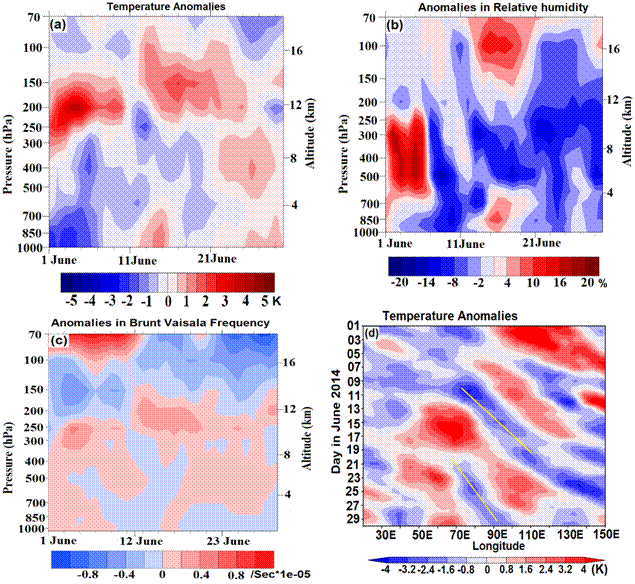 The authors investigate the life cycle of a strong subtropical stratospheric intrusion event and propose a hypothesis through which might reduce the intensity of the Indian-summer-monsoon rainfall (ISMR) after the monsoon onset during June 2014. The diagnostic analysis of ERA-Interim data revealed that stratospheric intrusion occurs in the region of Subtropical Westerly Jet (SWJ) due to Rossby Wave Breaking (RWB). The RWB event is associated with eddy shedding. These eddies transport extratropical stratospheric mass and energy fluxes downward and southward to North India (NI). As a result, the intrusion spread dry, cold and ozone rich air deep into the troposphere (~500hPa) over the NI. It enhances the static stability and weakens the North-South upper tropospheric temperature gradient. The intrusion of cold and dry air persisted for the entire June which might have inhibited northward propagation of ISM convection and could be responsible for prolonged hiatus in northward phase propagation of the ISM after onset. We also investigate the relation between stratospheric intrusion events and ISMR from long term data (1979-2007). Our analysis shows that the stronger negative anomalies of rainfall are associated with stratospheric intrusions during break spells. Thus study reveals that stratospheric intrusion is an important factor that may influence ISMR deficit.
(Fadnavis S., Chattopadhyay R., Journal of Climate, July 2017)
The authors investigate the life cycle of a strong subtropical stratospheric intrusion event and propose a hypothesis through which might reduce the intensity of the Indian-summer-monsoon rainfall (ISMR) after the monsoon onset during June 2014. The diagnostic analysis of ERA-Interim data revealed that stratospheric intrusion occurs in the region of Subtropical Westerly Jet (SWJ) due to Rossby Wave Breaking (RWB). The RWB event is associated with eddy shedding. These eddies transport extratropical stratospheric mass and energy fluxes downward and southward to North India (NI). As a result, the intrusion spread dry, cold and ozone rich air deep into the troposphere (~500hPa) over the NI. It enhances the static stability and weakens the North-South upper tropospheric temperature gradient. The intrusion of cold and dry air persisted for the entire June which might have inhibited northward propagation of ISM convection and could be responsible for prolonged hiatus in northward phase propagation of the ISM after onset. We also investigate the relation between stratospheric intrusion events and ISMR from long term data (1979-2007). Our analysis shows that the stronger negative anomalies of rainfall are associated with stratospheric intrusions during break spells. Thus study reveals that stratospheric intrusion is an important factor that may influence ISMR deficit.
(Fadnavis S., Chattopadhyay R., Journal of Climate, July 2017)
Moisture index during the last two centuries inferred from Western Himalaya tree growth, India
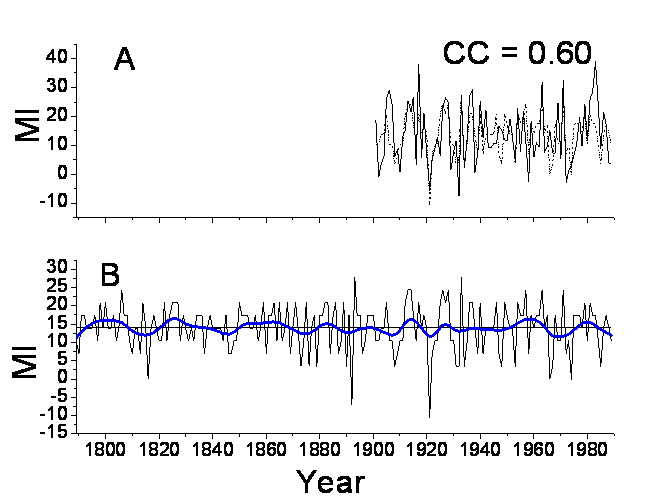 Aregionaltree-ring chronology prepared from two species (Piceasmithiana and Cedrusdeodara) over western Himalaya has been used in relation to climate fluctuations in present study. This analysis shows that moisture index and rainfall during (February to May) have significant positive relationship whereas temperature and heat index showed negative relationship with trees growth. But, moisture and heat index indicate more impact to trees growth than rainfall and temperature. The strong association of tree-rings chronology with moisture demonstrates that tree-rings are much more sensitivity to availability of moisture at trees root zone which enabled us to extend it back to AD 1789; consecutive two years moisture deficiency during 1846-1847, 1908-1909, 1921-1922, 1931-1932, 1947-1948, and 1966-1967 was noticed in the present reconstruction. (Somaru Ram and H.P. Borgaonkar, online June 2017)
Aregionaltree-ring chronology prepared from two species (Piceasmithiana and Cedrusdeodara) over western Himalaya has been used in relation to climate fluctuations in present study. This analysis shows that moisture index and rainfall during (February to May) have significant positive relationship whereas temperature and heat index showed negative relationship with trees growth. But, moisture and heat index indicate more impact to trees growth than rainfall and temperature. The strong association of tree-rings chronology with moisture demonstrates that tree-rings are much more sensitivity to availability of moisture at trees root zone which enabled us to extend it back to AD 1789; consecutive two years moisture deficiency during 1846-1847, 1908-1909, 1921-1922, 1931-1932, 1947-1948, and 1966-1967 was noticed in the present reconstruction. (Somaru Ram and H.P. Borgaonkar, online June 2017)
New Publications
IITM Events
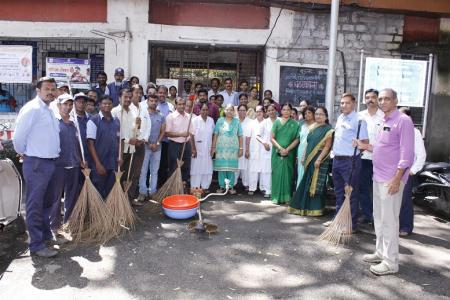
'Swachhta Hi Sewa' campaign at IITM
Institute observed 'Swachhta Hi Sewa (SHS)' campaign from 15th September 2017 to Gandhi Jayanti. Essay competition was held in the Institute on 20th September 2017, during Hindi Pakwada, in which one of the topic for essay competition was Swachh bharath Abhiyan. As a part of SHS campaign Swachtta pledge was taken by the staff and the officers of the Institute on 22nd September 2017. The staff and officers took active part in cleaning the premises of the nearby Municipal hospital. A short lecture was also given by Institute scientist to the patients about hygiene and cleanliness. On 27th September 2017 the staff and officers of the Institute cleaned and painted the Municipal School, Pashan. On this occasion some officers gave a lecture on cleanliness and hygiene to the students.
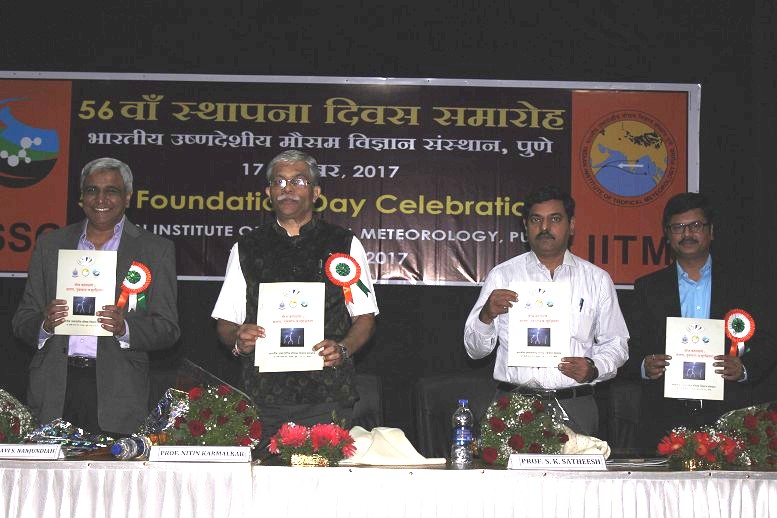
Marathi version of IITM publication on Lightning released
A Marathi version of a publication by IITM "Lightning: Causes, damages & Precautions" was released on the occasion of IITM's 56th Foundation Day on 17th November 2017 at the hands of chief guest of the function honorable Prof. Nitin Karmalkar, Vice Chancellor, Savitribai Phule Pune University, Pune
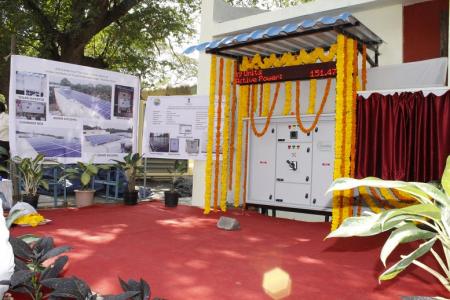
Rooftop Solar System of 230 KW capacity inaugurated at IITM
Indian Institute of Tropical Meteorology (IITM) inaugurated its 230.4 kWp Roof Top Solar Power plant on 24 November 2017 at the hands of Dr Rajeevan, Hon'ble Secretary, MoES, in presence of Dr K.J. Ramesh, Director General, IMD, Dr S.C. Shenoi, Director, NIOT, Dr. E.N. Rajagopal, Director, NCMRWF and Prof. Ravi S. Nanjundiah, Director, IITM. This initiative by MoES falls in line with Hon'ble Prime Minister Narendra Modi's call for building a solar powered nation.
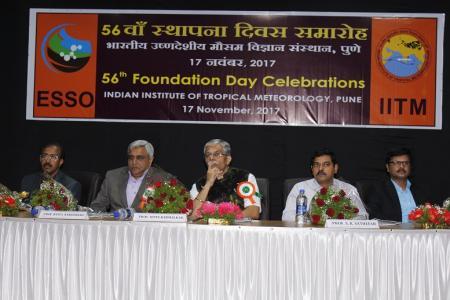
56th Foundation Day Celebration at IITM 17 November 2017
IITM celebrated 56th Foundation Day on 17th November 2017. Prof. Nitin Karmalkar, Vice Chancellor, Savitribai Phule Pune University, Pune and Prof. S.K. Satheesh, IISc, Bangalore, was the Chief Guest and Guest of Honor respectively. On this occasion various awards were presented to the scientists, students, scientific, technical, Administrative support and other staff of the Institute. On this occasion Prof. S.K. Satheesh, IISc., Bangalore delivered IITM Foundation Day lecture on the topic "Short-lived Climate Forcers: Science and Policy".

